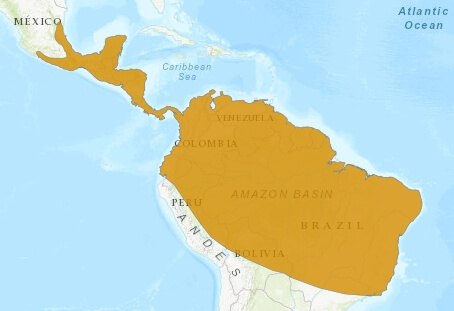Kinkajou
Potos flavus
©Tadeu de Oliveira
Taxonomy
Standard English Name
Kinkajou
Scientific Name
Potos flavus
Brazilian common name/s
Jupará-verdadeiro, macaco-da-meia-noite
Conservation status - IUCN
Physical Description
The Kinkajou is a carnivore with nocturnal habits that is strictly arboreal (lives in the trees) and whose tail is long and prehensile. They are approximately 50 cm in body length with a 40 cm tail, and weigh between 1.5 and 4.5 kg. It has dense, soft fur, which is reddish brown in colour but may also have lighter shades.
It is a species characteristic of tropical rainforests. In Brazil they mainly occur in the Amazon basin and northern Mato Grosso state, but Kinkajous are also found in areas of the Atlantic Forest.
Ecology and Habitat
Their diet consists mainly of fruits, but Kinkajou also eat insects such as ants and termites. An important feature is their long tongue, which allows them to feed on these insects and even nectar. Due to their diet, they have an important role as seed dispersers.
Its external appearance and eating habits make it appear more like a monkey than a carnivore, which is why the species came to be known in areas of the Amazon basin as the midnight-monkey (“macaco-da-meia-noite”).
Gestation is approximately 116 days and 1 to 2 young are usually born.
Threats and Conservation
The main threats to this species are habitat loss and poaching.
Online links
IUCN redlist (http://www.iucnredlist.org) presents a synthesis of current knowledge about distribution and conservation status.
References
Fleming, T. H., & Williams, C. F. (2009). Phenology, seed dispersal, and recruitment in Cecropia peltata (Moraceae) in Costa Rican tropical dry forest. Journal of Tropical Ecology, 6, 163-178.
Ford, L. S., & Hoffmann, R. S. (1988). Potos flavus. Mammalian Species, 321, 1-9.
Janson, C. H., Terborgh, J., & Emmons, L. H. (1981). Non-flying mammals as pollinating agents in the Amazonian forest. Biotropica, , 1-6.
Julien-Laferriere, D. (1999). Foraging strategies and food partitioning in the neotropical frugivorous mammals Caluromys philander and Potos flavus. Journal of Zoology, 247, 71-80.
Kays, R. W. (1999). Food preferences of kinkajous (Potos flavus): A frugivorous carnivore. Journal of Mammalogy, 80, 589-599.
Kays, R. W., & Gittleman, J. L. (1995). Home range size and social behavior of kinkajous (Potos flavus) in the Republic of Panama. Biotropica, 27, 530-534.
Kays, R. W., & Gittleman, J. L. (2001). The social organization of the kinkajou Potos flavus (Procyonidae). Journal of Zoology, 253, 491-504.
Michalski, F., & Peres, C. A. (2005). Anthropogenic determinants of primate and carnivore local extinctions in a fragmented forest landscape of southern Amazonia. Biological Conservation, 124, 383-396.
